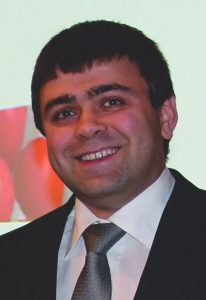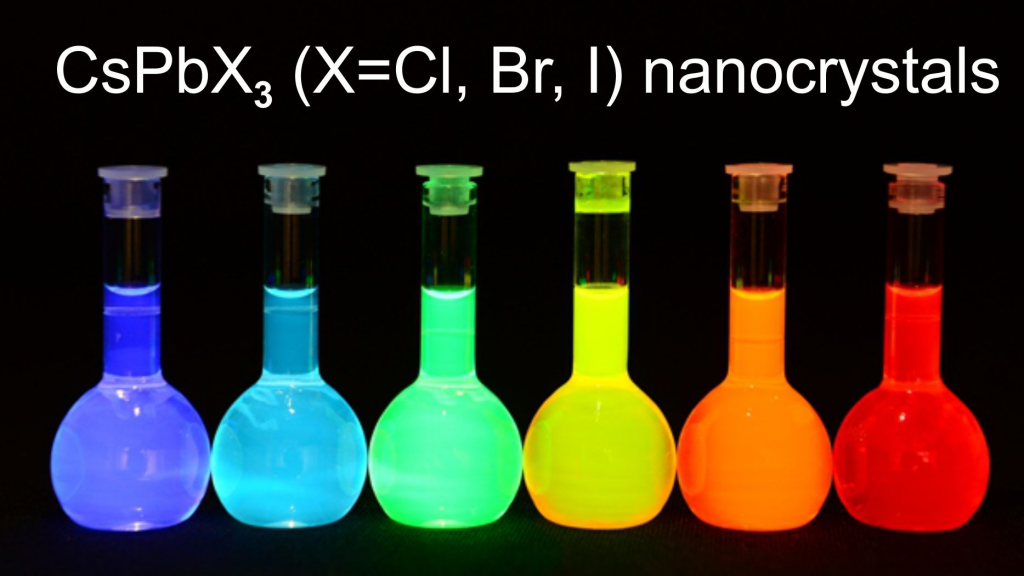Events
Nano- and single-crystals of lead halide perovskites: from bright light emission to hard radiation detection
February 7, 2017 at 4:30pm/36-428 RLE Haus Room
Maksym Kovalenko
ETH Zurich, Department of Chemistry

Chemically synthesized inorganic nanocrystals (NCs) are considered to be promising building blocks for a broad spectrum of applications including electronic, thermoelectric, and photovoltaic devices. We have synthesized monodisperse colloidal nanocubes (4-15 nm edge lengths) of fully inorganic cesium lead halide perovskites (CsPbX3, X=Cl, Br, and I or mixed halide systems Cl/Br and Br/I) using inexpensive commercial precursors [1]. Their bandgap energies and emission spectra are readily tunable over the entire visible spectral region of 410-700 nm. The photoluminescence of CsPbX3 NCs is characterized by narrow emission line-widths of 12-42 nm, wide color gamut covering up to 140% of the NTSC color standard, high quantum yields of up to 90% and radiative lifetimes in the range of 4-29 ns. Post-synthestic chemical transformations of colloidal NCs, such as ion-exchange reactions, provide an avenue to compositional fine tuning or to otherwise inaccessible materials and morphologies. While cation-exchange is facile and commonplace, anion-exchange reactions have not received substantial deployment. We observed fast, low-temperature, deliberately partial or complete anion-exchange in CsPbX3 NCs. By adjusting the halide ratios in the colloidal NC solution, the bright photoluminescence can be tuned over the entire visible spectral region (410-700 nm). Furthermore, fast inter-NC anion-exchange is demonstrated as well, leading to uniform CsPb(Cl/Br)3 or CsPb(Br/I)3 compositions simply by mixing CsPbCl3, CsPbBr3 and CsPbI3 NCs in appropriate ratios. We also present low-threshold amplified spontaneous emission and lasing from CsPbX3 NCs [3]. We find that room-temperature optical amplification can be obtained in the entire visible spectral range (440-700 nm) with low pump thresholds down to 5±1 µJ cm-2 and high values of modal net gain of at least 450±30 cm-1. Two kinds of lasing modes are successfully realized: whispering gallery mode lasing using silica microspheres as high-finesse resonators, conformally coated with CsPbX3 NCs, and random lasing in films of CsPbX3 NCs.
We also demonstrated that 0.3-1 cm, solution-grown single crystals (SCs) of semiconducting hybrid lead halide perovskites (MAPbI3, FAPbI3 and I-treated MAPbBr3, where MA=methylammonium, FA=formamidinium) can serve as solid-state gamma-detecting materials detectors (e.g. for direct sensing of photons with energies as high as mega-electron-volts, MeV) [4]. This possibility arises from a high mobility(µ)-lifetime(τ) product of 1.0-1.8 10-2 cm2 V-1, low dark carrier density of 109 – 1011 cm-3 and low density of charge traps of 109 – 1010 cm-3, and a high absorptivity of hard radiation by the lead and iodine atoms. We demonstrated the utility of perovskite detectors for testing the radio-purity of medical radiotracer compounds such as 18F-fallypride. Energy-resolved sensing at room temperature is presented using FAPbI3 single crystals (SCs) and an 241Am source. With FAPbI3 SCs, that amongst all tested crystals exhibit highest mobility-lifetime product and lowest noise levels and dark currents, a portable dosimetry prototype is demonstrated.
- Protesescu et al. Nano Letters 2015, 15, 3692–3696
- Nedelcu et al. Nano Letters 2015, 15, 5635–5640
- Yakunin et al. Nature Communications 2015, 9, 8056.
- Yakunin et al. Nature Photonics 2016, doi:10.1038/nphoton.2016.139
Maksym V. Kovalenko has been tenure-track Assistant Professor of Inorganic Chemistry at ETH Zürich (Swiss Federal Institute of Technology) since July 2011. His group is also partially hosted by Empa (Swiss Federal Laboratories for Materials Science and Technology) to support his highly interdisciplinary research program. He studied chemistry in Ukraine (1999-2004, Chernivtsi National University). His doctoral studies took place in Austria (2004-2007, Institute of Solid State Physics, Johannes Kepler University, Linz, with Prof. Wolfgang Heiss). He then moved to USA (2008-2011, Department of Chemistry, University of Chicago, with Prof. Dmitri Talapin). His present scientific focus is on the development of new synthesis methods for inorganic nanomaterials, their surface chemistry and assembly into macroscopically large solids. His ultimate, practical goal is to provide novel inorganic materials for photonics and optoelectronics, as well as for rechargeable Li-ion batteries and post-Li-electrochemistries. Recently, his group pioneered the synthesis of highly luminescent colloidal nanomaterials of cesium lead halide perovskites, which hold great potential for applications in display technologies and for lighting. With much larger forms of lead halide perovskites – inch-sized single-crystals – he recently demonstrated sensitive detection of hard radiation (hard X-rays and gamma photons).
He is the recipient of an ERC Starting Grant 2012, Ruzicka Preis 2013 and Werner Prize 2016. He published over 110 articles in peer-reviewed journals, co-authored 3 book chapters, and is listed as inventor in 8 patents. Research







